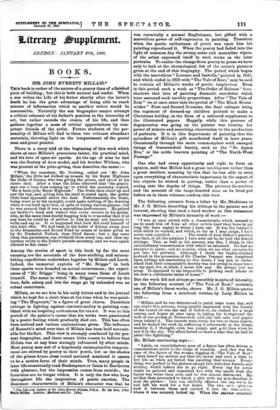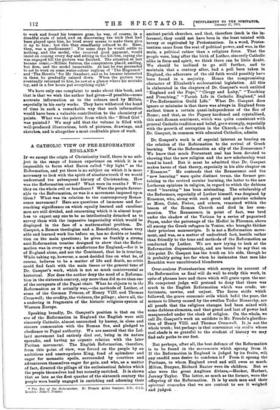BOOKS.
SIR JOHN EVERETT MILLAIS.*
THIs book is rather of the nature of a quarry than of a finished piece of building ; but this is both natural and useful. When a son writes the Life of his father shortly after the latter's
death he has the great advantage of being able to reach sources of information which to another writer would be inaccessible. Naturally the son biographer cannot attempt a critical estimate of his father's position in the hierarchy of art, but rather records the events of his life, and then gathers together a mass of critical appreciations by com- petent friends of the artist. Future students of the per- sonality of Millais will find in these two volumes abundant materials, throwing light on the temperament of the genial man and great painter.
There is a story told at the beginning of this work which shows at once Millais's precocious talent, his practical mind, and his love of open-air sports. At the age of nine he had won the Society of Arts medal, and his brother William, who was present at the prize-giving, thus describes the scene :—
"When the secretary, Mr. Cocking, called out Mr. John Millais,' the little lad walked up unseen by his Royal Highness the Duke of Sussex, who was giving the prizes, and stood at his raised desk. After a time the Duke observed that the gentle- man was a long time coming up,' to which the secretary replied, 'He is here, your Royal Highness.' The Duke then stood up and saw the boy, and, giving him his stool to stand upon, the pretty little head appeared above the desk. Unfortunately the Duke, being weak as to his eyesight, could make nothing of the drawing when it was held up to him, in spits of trying various glasses ; but he was assured that it was a marvellous performance. He patted my brother's head and wished him every success in his profes- sion, at the same time kindly begging him to remember that if at any time he could be of service to him he must not hesitate to write and say so. It so happened that Jack did avail himself of this kind offer. We had been in the habit of fishing every year in the Serpentine and Round Pond by means of tickets given us by Sir Frederick Pollock, then Chief Baron ; but a day came when this permission was withheld from every one, and then my brother wrote to the Duke's private secretary, and we were again allowed to fish there."
Among the stories of sport in this book by far the most amusing are the accounts of the deer-stalking and salmon- fishing expeditions undertaken together by Millais and Leech.
Indeed, the immortal exploits of "Mr. Briggs" in both these sports were founded on actual occurrences; the experi- ences of "Mr. Briggs " being in many cases those of Leech himself. The scene in which "Mr. Briggs," overcome by the heat, falls asleep and lets the stags go by unheeded was an actual occurrence.
Millais, as we see him in his early letters and in the journal which he kept for a short time at the time when he was paint- ing "The Huguenot," is a figure of great charm. Dauntless
courage in fighting against conventionality in painting com- bined with an inspiring enthusiasm for his art. It was at this period of the painter's career that his works were penetrated by a. poetic feeling which gradually died out. This has often been noticed and various explanations given. The influence
of Rossetti's mind over that of Millais has been held account- able for the fact. This view is strongly combated by the pre- sent biographer, and there seems little reason to believe that Millais was at any time strongly influenced by other minds.
Most young men not of a hopelessly unimaginative tempera- ment are stirred by poetry in their youth, but as the shades of the prison-house close round matured manhood it ceases to be a motive force of their minds. True, many people in later life occasionally read Shakespeare or listen to Beethoven with pleasure, but the impression comes from outside ; the fountains are no longer within. It is only the few who keep throughout life the inspiration of poetic emotion. The dominant characteristic of Millais's character was that he
The we and Letters of Sir John Everett Millais, P.R.A. By his Son, John Bailie Millais. London : Methuen and Co. Mal
was essentially a normal Englishman, but gifted with a marvellous power of self-expression in painting. Therefore when the poetic enthusiasm of youth was upon him his painting reproduced it. When the poetry had faded into tiro light of common day the strong sense and mescaline vigour of the artist expressed itself in each works as the later portraits. To realise the change from poetry to prose we have only to look at the chronological list of the artist's pictures given at the end of this biography. The period which began with the marvellous " Lorenzo and Isabella," painted in 1849, and which ended in 1858 with "The Vale of Rest," may be said to contain all Millais's works of poetic inspiration. Even in this period such a work as "The Order of Release" fore- shadows that love of painting dramatic anecdotes which later assumed such terrible proportions. After " The Vale of Rest" we at once enter into the period of "The Black Bruns- wicker " First and Second Sermons, the final collapse being the regiment of dressed-up children painted to make a Christmas holiday, in the form of a coloured supplement to the illustrated papers. Happily, while this process of degeneration was going on the painter was turning his power of minute and searching observation to the production of portraits. It is in this department of painting that the splendour of Millais's gift manifested itself in later years. Occasionally through the more commonplace work emerged things of transcendent beauty, such as the " St. Agnes Eve," or the noble bravura painting of "The North-West Passage."
One who had every opportunity and right to form an opinion, said that Millais had a great intelligence rather than a great intellect, meaning by this that he was able to seize upon everything of characteristic importance in the aspect of the objects he wished to portray, rather than a power of seeing into the depths of things. The pictures themselves and the account of the large-hearted man as he lived put before us in these volumes confirm this view.
The following extracts from a letter by Mr. Gladstone to Mr. J. G. Millais describing his sittings to the painter are of interest, showing that each a hard worker as this statesman was impressed by Millais's intensity of work :-
"I was at once struck with a characteristic which seemed to me to mark him off from all other artists (and they have in my long life been many) to whom I have sat. It was the intensity with which he worked, and which, so far as I may judge, I have never seen equalled The result of your father's practice was that, of all the painters I have ever sat to, he took the fewest sittings. This, as well as his success, was due, I think, to the extraordinary concentration with which he laboured. He had no energies to spare ; and no wonder, when we see what energies he put into his pictures. Although I think the highly-finished portrait in the possession of Sir Charles Tennant was completed upon sittings not amounting to five hours, I beg you to under- stand that their comparative brevity was not owing to impatience on my part, for, in truth, I never felt any. He always sent me away. It appeared to me impossible to prolong such labour as his over a continuous series of hours."
But the work did not always go smoothly in spite of intensity, as the following account of " The Vale of Rest," certainly one of Millais's finest works, shows. Mr. J. G. Millais quotes the following from a notebook written by Lady Millais in 1858 :— " Millais said he was determined to paint nuns some day, and one night this autumn, being greatly impressed with the beauty of the sunset (it was the end of October), he rushed for a large canvas, and began at once upon it, taking for background the wall of our garden at Bowerswell, with the tall oaks and poplar trees behind it. The sunsets were lovely for two or three nights, and he dashed the work in, softening it afterwards in the house, making it, I thought, even less purple and gold than when he saw it in the sky. The effect lasted so short a time that he had to paint like lightning."
Mr. Millais continuing says :—
" Again, an unsatisfactory pose of a figure has often driven a conscientious artist to the verge of insanity. And this was the case of the figure of the woman digging in The Vale of Rest.' I have heard my mother say that she never had such a time in her life as when my father was painting that woman. Every- thing was perfect in the picture except this wretched female, and nothing would induce her to go right. Every day for seven weeks he painted and repainted her, with the result that the figure was worse than ever, and he was almost distracted. My mother then proceeded to hatch a plot with my grandmother to steal the picture ! This was skilfully effected one day when he had left his work for a few hours. The two arch - plotters took it between them and carried it into the wine-cellar. where it was securely locked up. When the painter returned
to work and found his treasure gone, he was, of course, in a dreadful state of mind, and on discovering the trick that had been played upon him, he tried every means to make them give it up to him ; but this they steadfastly refused to do. Here, then, was a predicament ! For some days he would settle to nothing, and the model, who received good payment, would insist on coming every day and sitting in the kitchen, saying she was engaged till the picture was finished. The situation at last became comic,—Millais furious, the conspirators placid, smiling, but firm. and the model immovable. At last he was persuaded to set to work on some water-colour replicas of `The Huguenot' and 'The Heretic' for Mr Gambart, and as he became interested in them he gradually calmed down. When the picture was eventually returned to him, he saw at a glance where his mistake lay, and in a few hours put everything right."
We have only one complaint to make about this book, and that is that we wish the author had given—if possible--some accurate information as to the colours used by Millais, especially in his early works. They have withstood the hand of time in such a remarkable way that such information would have been a valuable contribution to the chemistry of paints. What was the palette from which the " Blind Girl " was painted P We may add that the volume is filled with well-produced illustrations, both of pictures, drawings, and sketches, and is altogether a most creditable piece of work.



















































 Previous page
Previous page